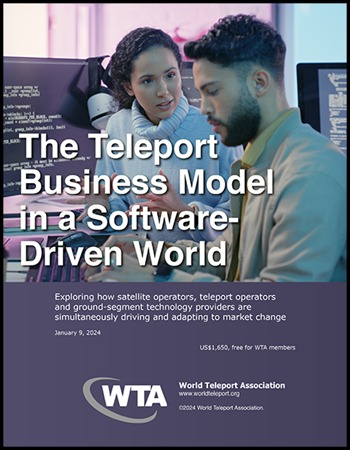Pivoting from Danger to Major Opportunity
by Robert Bell
New York City, April 5, 2024 - The teleport business is nothing if not adaptable. Four decades ago, operators offered bare-bones uplink and downlink services for a small handful of geostationary (GEO) satellite operators. Today, they are increasingly providing multipath, multi-orbit connectivity to a variety of enterprise and government customers, from maritime, energy and mobility to ISPs and military customers.
New technologies and market trends are disrupting the industry as never before. Companies are rolling out low-latency services from non-geostationary orbit (NGSO) constellations, while the capacity and sophistication of GEO satellites have grown dramatically. One result is a major reduction in bandwidth prices, with no end in sight.
On the ground, software-defined wide area network (SD-WAN) and virtualization technologies are making operators far more agile and responsive, both in space and on the ground. Satellite-based services are becoming more closely integrated with the terrestrial grid: service providers are incorporating cloud processing into their services, while cloud providers are using satellites for backhaul. Mobile network operators (MNOs) continue to use satellites for cellular backhaul, and satellite direct-to-device services are becoming more widely available. How far this integration can go in the 5G world is the billion-dollar question facing the industry.
Rising Pressure on the Business Model
 |
In a new report, The Teleport Business Model in a Software-Driven World, WTA examines how satellite and teleport operators, together with their tech vendors, are driving these changes and adapting to changes forced upon them. It paints a picture of the kind of “thriving on chaos” environment well-known to the tech sector but one that the satellite industry is still trying to get its arms around.
The story begins, of course, with the arrival of LEO broadband systems, led by Starlink. They are having the biggest disruptive impact on the industry, followed by the growing prevalence of software-defined satellites in GEO and medium Earth orbit (MEO). Together, developments are forcing ground segment operators to rethink their costs and pricing, how network architectures can incorporate verticalized satellite services, and how to break down longstanding silos now viewed as impediments to the industry’s growth.
Contributors to this report were also nearly unanimous in expecting a rising tide of consolidation among satellite operators. “It makes too much sense not to,” one teleport executive told us. This consolidation will involve satellites in all orbits, as well as ground-segment operators that resell satellite capacity, respondents said.
Adaptation in Progress
That’s the bad news part of the story. The good news is that, while LEO services are putting pressure on GEO operators, they are simultaneously opening up markets previously unavailable to satellite. Teleport operators are responding by expanding their offerings to include NGSO and terrestrial services, and in the process embracing software-defined networks, automation, and virtualization.
Value-Added Services
Amid the ongoing decline in bandwidth prices and other pressures, teleport operators are increasingly offering end-to-end turnkey solutions that include value-added services such as network monitoring, IT services, cloud integration and cybersecurity. In some cases, this is putting them in direct competition with the big satellite operators, who are similarly moving down the food chain.
Terrestrial Integration
The LEO-driven expansion of satellite into new markets, coupled with the shift by ground-segment operators to software-defined networks and standards, will create new opportunities for integration with the terrestrial grid. Our respondents tended to differ, however, on the pace and extent of that integration, and some said the large telcos and MNOs will dictate how that plays out.
The Customer Was Always Right
For most of its history, satellite communications has been shaped by scarcity. Assets in space were vanishingly small compared to terrestrial alternatives. Capacity was highly limited and it took great ingenuity with frequencies and waveforms to expand it. Everything was custom-made to proprietary standards or no standard at all.
Scarcity fostered a “take it or leave” attitude by the industry. It forced satcom customers to adapt what they wanted to the satellite network’s limited capabilities. Contrast that the very different approach of Amazon and Blue Origin founder Jeff Bezos: “We're customer obsessed. We start with what the customer needs and we work backwards.”
The most exciting development revealed by this report is that, at long last, the satcom service business is beginning to offer customers what they have wanted all along: the quality of service they need, where they need it, without technical complexity (for them). That’s a business model with huge potential. It should encourage us all that, according to attendees at the latest Mobile World Congress, mobile operators are voicing concerns about satellite taking away their customers. Wouldn’t that be a thing?
--------------------------------------------
 Robert Bell is the executive director of the World Teleport Association (www.worldteleport.org), which conducts research into the teleport and satellite industry, provides a unified voice for teleport operators and offers Teleport Certification programs to service providers. The Teleport Business Model in a Software-Driven World is available for free to members and for sale to non-members at https://www.worldteleport.org/store/viewproduct.aspx?id=23264901. He can be reached at: rbell@worldteleport.org
Robert Bell is the executive director of the World Teleport Association (www.worldteleport.org), which conducts research into the teleport and satellite industry, provides a unified voice for teleport operators and offers Teleport Certification programs to service providers. The Teleport Business Model in a Software-Driven World is available for free to members and for sale to non-members at https://www.worldteleport.org/store/viewproduct.aspx?id=23264901. He can be reached at: rbell@worldteleport.org





